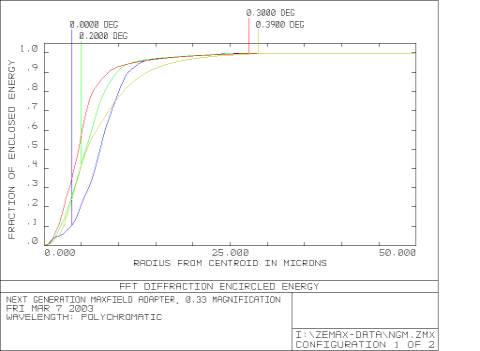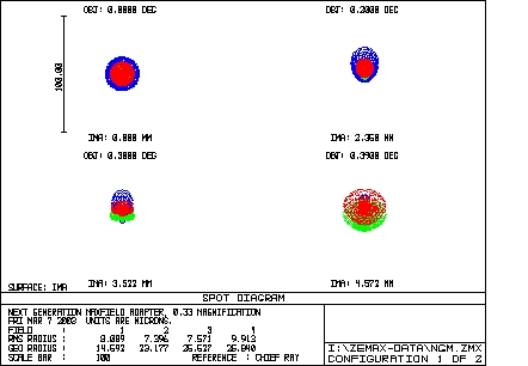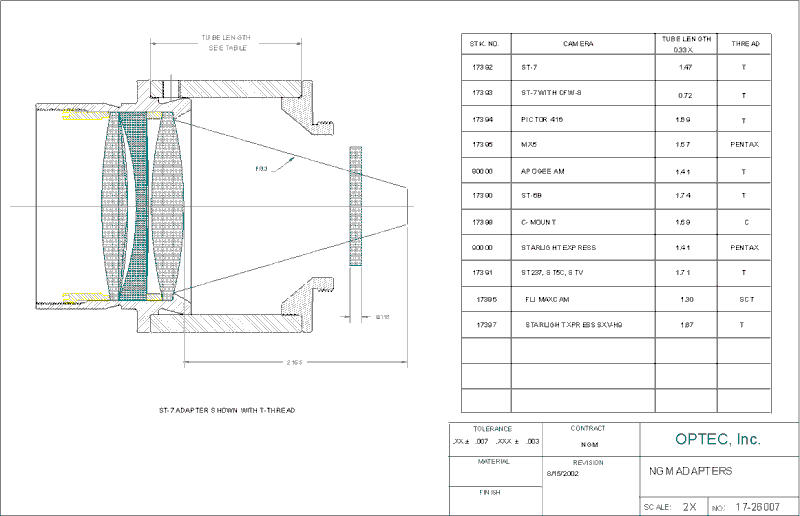Optec Distribution
![]() News
News ![]() Notes & Literature
Notes & Literature ![]() Overview
Overview ![]() Pricing
Pricing ![]() Products
Products
Temperature Compensating Focuser
![]() Color Filter Wheel
Color Filter Wheel
![]() Filters
Filters
![]() Lenses, Optics
Lenses, Optics
![]()


Optec Next Generation MaxField (NGM) 0.33X Telecompressor

Above: Raytrace showing the function of the Optec NGM MaxField Telescompressor
whose components include Positive Lens and Field Flattener elements (180,983 bytes)
The NGM 0.33X telecompressor lens system is Optec's successor to their original MAXfield system. The Next Generation MaxField offers the widest field of view available for CCD applications with Meade Instruments, or Celestron f10 Schmidt-Cassegrain telescopes. Note that this MaxField system is not recommended for f/6.3 SCT systems, or for use with other telescope designs. The lens could be employed in terrestrial applications if the great light gathering power of the larger aperture SCT's is desired.
Those with experience using CCD cameras on relatively large, or extended objects soon realize the value of having a wider field of view. At prime focus, even the larger TC-241 chip of the SBIG ST-6 camera provides only about 1/14th the area of that provided by a the 35mm film format. So for digital astrophotography of larger objects, a good telecompressor can be a good alternative to buying another telescope that may provide the shorter focal length. The NGM provides the needed telecompression by acting as a 0.33X focal reducer, thus the f/10 Schmidt-Cassegrain telescope can perform as a fast f/3.3 optical system. This makes centering and composing an image easier than ever. While the field of view at f/3.3 now covers nine times the area than at f/10, corresponding to the change of Effective Focal Length the exposure times are also decreased.
This optical system comprises a set of three lens elements, with two air spaces. This optics group is engineered to allow for improved correction of the field curvature and spherical chromatism that afflicts these types of instruments. All air spaced lens surfaces have a multilayer broadband anti-reflection coating to diminish undesirable reflections, and improve light throughput. At f/3.3 the maximum corrected field has a diameter of 9 mm at the image plane which makes the unit suitable for CCD cameras with imaging chips of the same diagonal dimension or smaller.
And for CCD color imaging, the NGM is primarily optimized for the wavelengths of 450, 550 and 650 nm; these are the center wavelengths for the commonly used CCD RGB filter systems. Secondary weight was given to 850 nm light during the optimizing process. Thus, use of the NGM telecompressor with no filter except the violet light rejection filter, will provide will corrected images using the full spectral sensitivity of the CCD. As in all refractive systems of this type, the violet wavelengths are the least corrected. As a result, an Optec violet light rejection filter is supplied with the NGM which blocks all light with wavelengths shorter than 415 nm.

Above: Chromatic performance of the Next generation MaxField Telecompressor, 7 March 2003 (149,001 bytes)
In order to achieve the proper effective focal length reduction, and the best overall correction, a back focus distance of 55 mm (assuming 3 mm for the CCD window) must be maintained. The system is modular so that the MaxField can be employed with a variety of CCD imaging systems. Company Seven can provide a variety of Optec supplies various length adapters which match the NGM to most popular camera and thread fittings. While other reductions are possible by varing the back focus distance, the best corrected image is obtained with the 55 mm distance.

Above: Spot Diagram of the Next generation MaxField Telecompressor, 7 March 2003 (150,445 bytes)
 Above: Drawing of Next Generation MaxField Telecompressor shwon with SBIG ST-7 CCD Camera Adapter and T-Thread.
Above: Drawing of Next Generation MaxField Telecompressor shwon with SBIG ST-7 CCD Camera Adapter and T-Thread.At right is a table illustrating draw tube lengths and compatibility of fittings. (146,474 bytes)
Benefits and features include:
![]() Nine times more imaging area provided on a CCD than at f/10.
Nine times more imaging area provided on a CCD than at f/10.
![]() Shorter exposures times.
Shorter exposures times.
![]() Can attach to either standard SCT rear-cell thread or slip fit 2" focusers.
Can attach to either standard SCT rear-cell thread or slip fit 2" focusers.
![]() Threaded lens cell accepts optional 2" filters.
Threaded lens cell accepts optional 2" filters.
![]() Mounting Kits are available for most astronomical CCD cameras.
Mounting Kits are available for most astronomical CCD cameras.
![]() Moderate cost.
Moderate cost.
Click here to review the current price lists for all Optec products.
Contents Copyright 1994-2003 Company Seven All Rights Reserved

